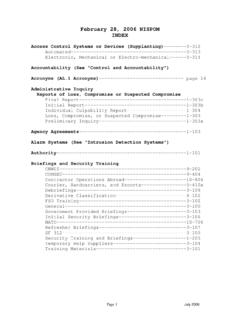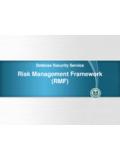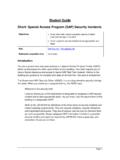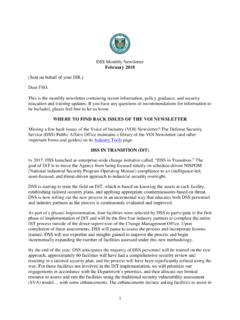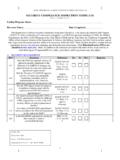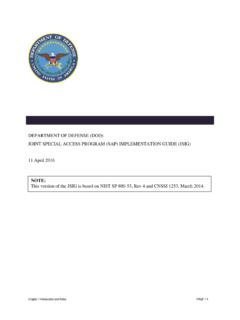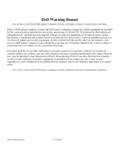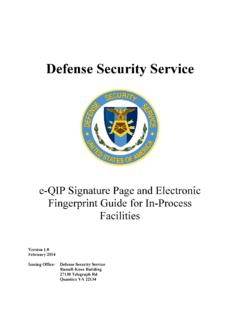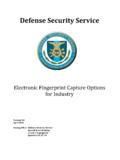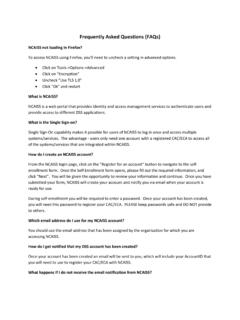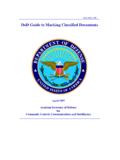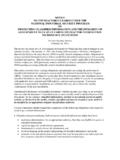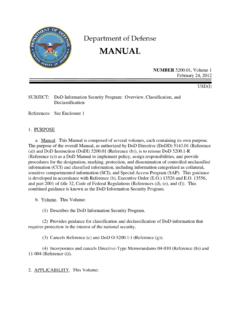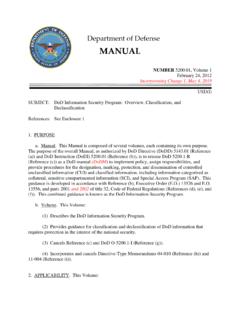Transcription of Student Guide Short: Requirements for OCAs
1 Student Guide Requirements for OCAs Page 1 Student Guide short : Requirements for OCAs Objective Identify the annual training Requirements for original classification authorities (OCAs) as specified in 13526 POC Estimated completion time 10 minutes Overview On December 29, 2009, President Obama signed Executive Order 13526 classified National Security information . This Executive Order calls for a uniform system for classification, safeguarding, and declassification of national security information . According to this Executive Order, as an Original Classification Authority, or OCA, you must receive training in these topics at least once per calendar year.
2 This annual training is required; failure to complete it could result in suspension of your classification authority until you do so. Refresher Training Topics To complete your OCA annual training requirement, you must review the following topics: proper classification, including the avoidance of over classification; proper safeguarding of classified information ; declassification; and sanctions. 1. Classification There are a few things to remember about classification. As you know, if there is any significant doubt about the need to classify information , the information should not be classified . Similarly, if there is any significant doubt about the appropriate level of classification, the information should be classified at the lower level.
3 Even with this requirement to err on the side of a lower classification, remember that unauthorized disclosure of classified information does not mean it automatically becomes unclassified. There are also a few things to remember about delegated classification authority. First, delegations of original classification authority must be limited to the minimum needed to administer the Requirements in 13526. Delegated officials must have a demonstrable and continuing need for the authority and OCAs may not redelegate this authority to their subordinates. Once an OCA is authorized to classify information at a Student Guide Requirements for OCAs Page 2 specified level, however, he or she is also authorized to classify information at a lower level.
4 2. Safeguarding When it comes to safeguarding classified information , there are a few details to review. First, remember that individuals may access classified information only if a favorable determination of eligibility for access has been made, the individual has signed an approved nondisclosure agreement, and he or she has a need to know the information . Once access is granted, individuals with access must protect classified information by securing it in approved storage containers or facilities when it is not in use, by meeting safeguarding Requirements as prescribed in DoD , and by ensuring that the classified information is not communicated in a manner that would allow it to be inappropriately disclosed.
5 It should not be sent over unsecured voice or data circuits, discussed in public places, or transmitted in any other unsecured manner. Finally, remember there are restrictions on removing and sharing classified information . classified information may be shared with other government agencies, even without originating agency consent, as long as the criteria from 13526 are met. Individuals, however, must not take classified information from official agency premises without proper authorization. Finally, officials or employees leaving agency service may not remove classified information , or declassify the information in order to remove it.
6 3. Declassification As you know, at the time of original classification, OCAs must also establish a specific date or event for the declassification of information . information will be automatically declassified when it reaches this date or event, except for information that might reveal the identity of a confidential human source or a human intelligence source, or key design concepts for weapons of mass destruction. Review the options for declassification shown here: A date or event 10 years from original classification A date or event up to 25 years from original classification 25X1 through 25X9, with a date or event 50X1 HUM or 50X2 WMD, or information Security Oversight Office (ISOO)-approved designator reflecting the Interagency Security Classification Appeals Panel (ISCAP) approval for classification beyond 50 years For additional guidance on exemptions, please refer to Executive Order 13526 and information Security Oversight Office, or ISOO, Directive 1.
7 Student Guide Requirements for OCAs Page 3 4. Sanctions As you know, government officers, employees, contractors, and others charged with the safeguarding of classified information , are subject to sanctions if they knowingly, willfully, or negligently disclose classified information to unauthorized individuals. Remember, however, that these individuals are also subject to sanctions if they classify information needlessly, if they create or continue special access programs that aren t required, or if they disregard any other provision of 13526 or its implementing directives. Sanctions may include reprimand, suspension without pay, removal, termination of classification authority, loss or denial of access to classified information , or other sanctions in accordance with laws and regulations.
8 At the very least, supervisory officials must promptly remove the classification authority of any individual who shows reckless disregard for the classification standards, or a pattern of errors in the application of these standards. The Original Classification Process You may already be familiar with the six-step process that OCAs follow when determining whether to classify information . If at any step the information does not meet the criteria for classification, the process will terminate and the OCA will not classify the information . You can refresh your knowledge of this process here. Step 1: Is the information official?
9 Is it: Owned by the Government? Owned by is information that belongs to the Government. Produced by or for the Government? Produced by is government-developed information . Produced for is when the government enters into an agreement through purchase, lease, contract, or receipt of the information as a gift. It covers situations in which the government uses a contractor. Under the control of the Government? Under the control is the authority of the originating agency to regulate access to the information . The contractor, inventor, etc., agrees to have the Government place it under their control so that the information is eligible for protection through classification.
10 The contractor still retains ownership, but has entrusted the information to the Government. Student Guide Requirements for OCAs Page 4 Step 2: Is the information eligible to be classified ? Perform an eligibility analysis Does the information fall within one of 8 eligible categories? 1. Military plans, weapons systems, or operations 2. Foreign government information (FGI) 3. Intelligence activities (including covert action), intelligence sources or methods, or cryptology 4. Foreign relations or foreign activities of the United States, including confidential sources 5. Scientific, technological, or economic matters relating to the national security, which includes defense against transnational terrorism 6.
